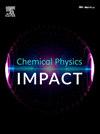磁性rGO/AK/Fe3O4纳米复合材料吸附去除亚甲基蓝染料:吸附等温线、动力学和热力学研究
IF 3.8
Q2 CHEMISTRY, PHYSICAL
引用次数: 0
摘要
有机染料具有毒性、诱变性和致癌性。被染料污染的水会对水生系统和人类造成严重威胁。因此,应对被有机染料污染的水系统进行处理。研究了一种可重复使用的合成还原氧化石墨烯/活性高岭土/磁铁矿(rGO/AK/Fe3O4)三元纳米复合材料去除亚甲基蓝(MB)染料的新方法。通过简单、环保的单步工艺合成了还原氧化石墨烯(rGO)基磁活化高岭土纳米材料。Fe3O4、rGO和高岭土基材料具有独特的结构、高比表面积和可定制的官能团,具有很大的吸附剂潜力。采用超声辅助化学共沉淀法,在还原氧化石墨烯(rGO)纳米片和AK表面包覆了纳米Fe3O4。采用x射线衍射(XRD)、扫描电子显微镜(SEM)和傅里叶变换红外光谱(FTIR)对rGO/AK/Fe3O4复合材料的晶体结构、形貌和官能团进行了表征。研究了亚甲基蓝染料在三元纳米复合材料上的吸附性能。所合成的纳米复合材料在pH为10,初始浓度为15 ppm,吸附剂剂量为5 ~ 50 mg时,对MB的去除率为66 ~ 98.2%。为了研究染料分子与吸附剂的相互作用,我们采用了四种吸附等温线模型:Freundlich、Langmuir、Temkin和Dubinin-Radushkevich。Langmuir模型在pH为10、K为298时的拟合R2值为0.996。采用3种不同的动力学模型对pH值为10时的吸附数据进行了分析,发现线性化的伪二级动力学模型最适合我们的吸附实验,其R2值为0.998。热力学参数也进行了评估。在298 K时,ΔHo、ΔGo和ΔSo的负值分别为-54.8 kJ/mol、-9.91 kJ/mol -1和-150.65 J/molK;分别揭示了放热、自发和较少无序(良好的吸附剂-染料亲和力)的过程。可重用性测试显示,即使在第5次循环后,仍有98.1%的去除能力。因此,纳米复合材料在去除MB染料方面表现出良好的稳定性和可重复使用性。本文章由计算机程序翻译,如有差异,请以英文原文为准。

Adsorptive removal of methylene blue dye by a ternary magnetic rGO/AK/Fe3O4 nanocomposite: Studying adsorption isotherms, kinetics, and thermodynamics
Organic dyes have very toxic, mutagenic, and carcinogenic properties. Contamination of water by dyes can cause serious threats to aquatic systems and humankind. Therefore, water systems contaminated with organic dyes should be treated. A new cost-effective method for removing methylene blue (MB) dye using a reusable synthetic reduced graphene oxide/activated kaolin/magnetite (rGO/AK/Fe3O4) ternary nanocomposite was developed. The synthesis of reduced graphene oxide (rGO)-based magnetic activated kaolin nanomaterial was achieved through a simple, environmentally friendly, and single-step process. Fe3O4, rGO, and kaolin-based materials with distinct structures, high specific surface areas, and customizable functional groups show great potential as adsorbents. Magnetite nanoparticles (Fe3O4) were coated on reduced graphene oxide (rGO) nanosheets and AK surface by chemical co-precipitation method supported by ultrasonication. It is characterized by X-ray diffraction (XRD), Scanning electron microscopy (SEM), and Fourier transform infrared (FTIR) spectroscopy to investigate the crystal structure, morphology, and functional groups present in rGO/AK/Fe3O4 composites, respectively. The adsorption of methylene blue dye onto the ternary nanocomposite was studied. The synthesized nanocomposite showed 66–98.2% removal of MB at pH 10, initial concentration of 15 ppm with the range of adsorbent dose 5 - 50 mg. To examine the interaction of dye molecules with the adsorbent, we employed four adsorption isotherm models: Freundlich, Langmuir, Temkin, and Dubinin-Radushkevich. The Langmuir model yielded the best fit with an R2 value of 0.996 at pH 10 and 298 K. The kinetic data were analyzed with three different kinetic models at pH 10 and the linearized pseudo second-order kinetic model was found to be the best fit model for our adsorption experiment with an R2 value of 0.998. Thermodynamic parameters were also evaluated. The negative values of, ΔHo, ΔGo and ΔSo were calculated to be -54.8 kJ/mol, -9.91 kJmol-1, and -150.65 J/molK at 298 K; revealing the exothermic, spontaneous, and less disordered (good adsorbent-dye affinity) process, respectively. The reusability test exhibited 98.1 % removal capacity even after the 5th cycle. Thus, the nanocomposite material showed excellent stability and reusability for removing MB dye.
求助全文
通过发布文献求助,成功后即可免费获取论文全文。
去求助
来源期刊

Chemical Physics Impact
Materials Science-Materials Science (miscellaneous)
CiteScore
2.60
自引率
0.00%
发文量
65
审稿时长
46 days
 求助内容:
求助内容: 应助结果提醒方式:
应助结果提醒方式:


